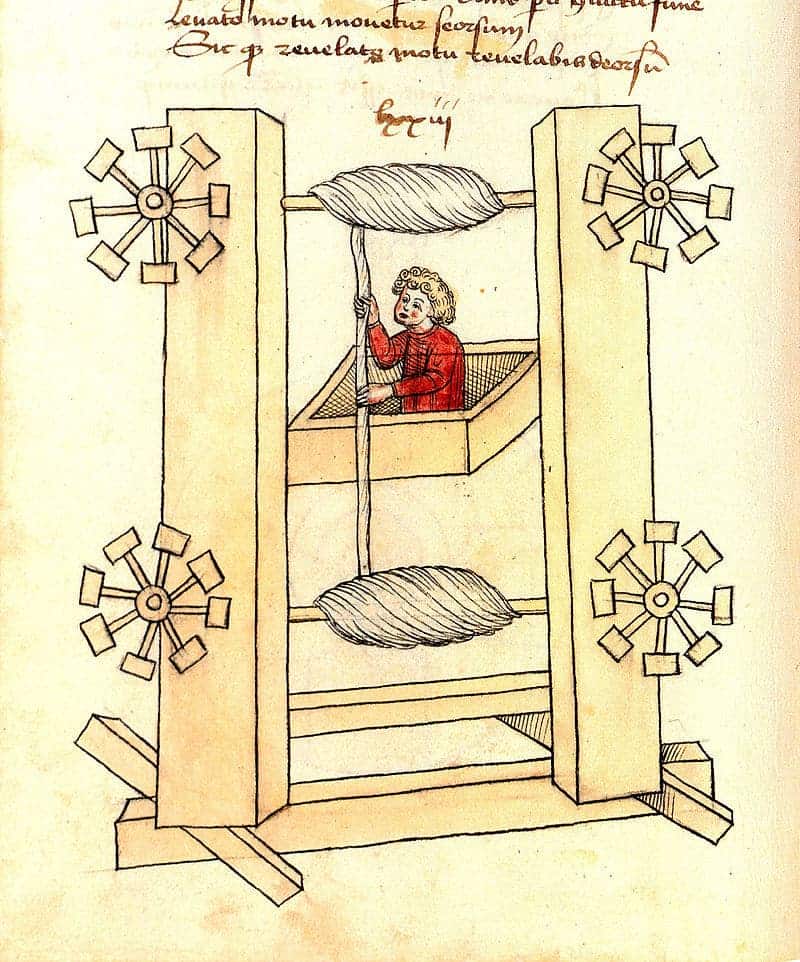Whether they lift you up or bring you down, elevators are a pretty common sight in developed countries. Although they’ve been around in various forms since Antiquity, proper elevators are a rather modern invention, from around 150 years ago — so let’s take a look at how they came to be.

How it all went down (and up again) — pulleys
Their story begins in Antiquity in the form of pulleys. These simple machines are comprised of blocks and tackle. They help apply force more efficiently when pulling or lifting weights. As a rule of thumb, the force needed to move a given object in a pulley is equal to its weight divided by the number of blocks in the system. You can also view this as the system multiplying force (i.e. it gives a mechanical advantage) by the number of blocks in the pulley system.
Greater mechanical advantage (ME) lets you apply a weaker force over a greater distance to achieve the same task. Let’s consider a weight of 100 kgs. In a system with an ME of 1 (one block), you have to apply 100 kgs of force and pull on 1 m of rope to lift the weight 1 m. In a system with an ME of 2 (two blocks), you only need 50 kgs of force, but you have to pull on 2 m of rope to move the weight 1 m.

Image via Pixabay.
The application of force over a distance is called mechanical work. Pulleys are especially great in pre-industrial societies, which tend to rely heavily on muscle power. Muscle power isn’t very fuel-efficient, and pretty much capped per head of human or animal (unless they can spontaneously grow more muscles). A man on a pulley, however, can perform the work of several without pulleys. It spreads the force over a greater distance, allowing a weak ‘engine’ to perform work on a heavy load.
As such, pulleys (in the form of hoists) saw wide use in construction and freight handling as early as the 3rd century BC — although they were likely used earlier, we have no definitive proof. They were generally muscle-driven, although some evidence of water-driven systems has been found.
Elevating elevator knowledge
Greek inventor and overall awesome guy Archimedes is generally credited with developing the first system we’d recognize as an elevator. This is mostly based on the accounts of Vitruvius. Archimedes was a bright guy, and greatly expanded the understanding of mechanics in his day and age. One of his main areas of interest was the lever and fulcrum, and their workings. Vitruvius writes that his elevator was quite simple — a wooden platform on hemp ropes hoisted around a drum, powered by people (possibly slaves).

Image in Public Domain, via Wikimedia.
There is further proof that ancient peoples actually understood the working principles of the pulley, which underpins the elevator and didn’t play it by ear. It also ties in closely to Archimedes’ work. Writing in Mechanical Problems — an awesome book, dealing with mechanical concepts in a very pleasant way, I find — Aristotle ponders their use thusly:
“Why is it that if one puts two pulleys on two blocks which support each other in opposite directions, and passes a rope round them in a circle […] one can draw up great weights, even if the dragging force is small?” the book reads.
“The pulley acts in the same way as the lever, so that even one will draw the weight more easily and will raise a much heavier weight with less pull than by hand. And two pulleys will quickly raise more than twice as much. For the second rope is drawing even less weight than it would be, if it were drawing by itself, when the one rope is passed over the other; for that makes the weight still less.”
Rome also used elevators in style — they brought wild beasts from the belly of the Coliseum up to the blood-soaked sands of the arena.
However, there was one bit still needed to create the Modern Elevator: counterweights. And, as often happens in history, one man’s quest to more easily reach his beloved (mistress) will bring progress into the picture.
Balancing it all out
It’s 1743, you’re the king of France, and your mistress is a scandalous distance away from your affections — living one whole floor above your apartment in the Versailles palace. This can’t possibly stand, can it? Louis XV, patron of arts and architecture, ‘Beloved’ to his people — and the last French king not to lose his head in a guillotine – agreed. This was too much for royalty to bear. So he had an elevator installed on his balcony.
Louis’ elevator, dubbed “The Flying Chair“, is among the first home elevators that we have solid proof of. But it was also one of the first — if not the first — real elevators from a technical standpoint: it had counterweights.
Counterweights are an integral part of elevators today. In essence, they’re a lump of something (anything dense works, really) tied to one end of the rope. This mass makes it easier to lift or lower the cabin on the other end. If we think of elevators as systems of pulleys, and of pulleys as a type of lever, the counterweight helps bring the two ends of the lever close to balance. The result is that you need even less force to raise one end of the lever (since the counterweight provides part of the ‘work’ we talked about earlier). It makes the elevator easier to pull up and harder to pull down.
In practical terms, this counterweight means that any engine powering an elevator only needs to lift a fraction of its real weight. It also acts as a break, slowing the elevator as it goes down, to prevent accidents.
In general, counterweights are designed to be the same weight as the elevator carriage plus 40% to 50% of its intended carrying weight. This is meant to reflect practical realities, as elevators aren’t generally filled to the brim. Limiting the counterweight is a compromise between trying to reduce wear on the engine and other moving parts while still bringing an acceptable level of balance to the whole system.


